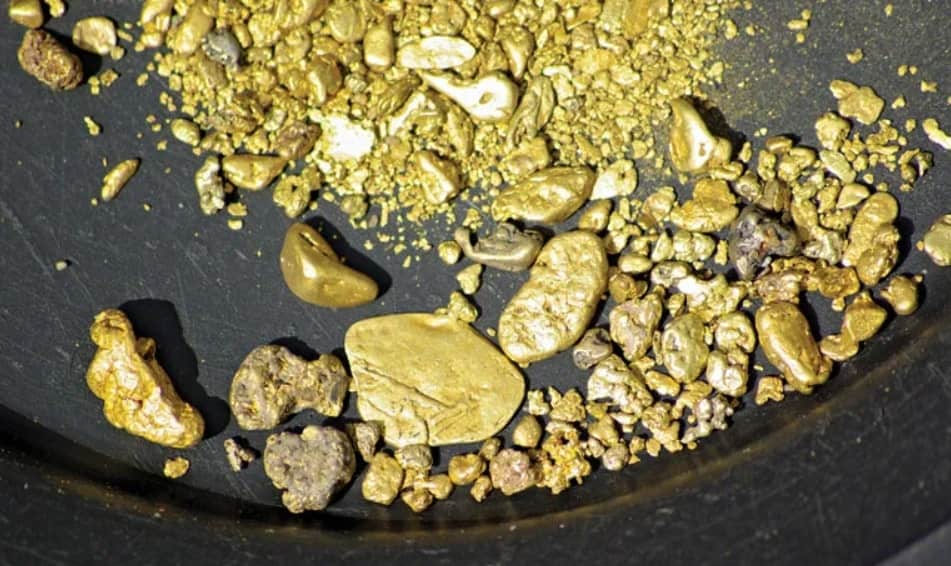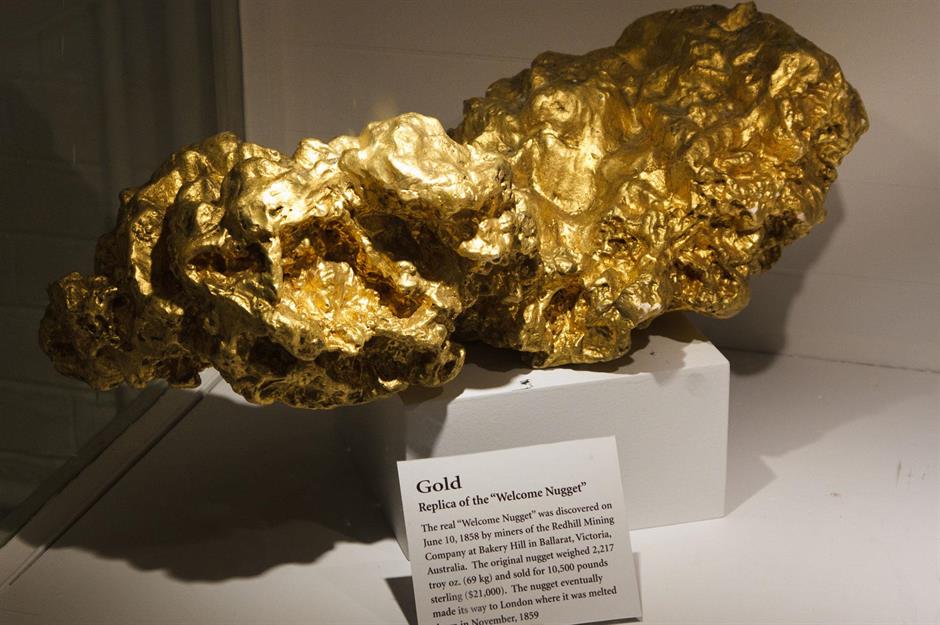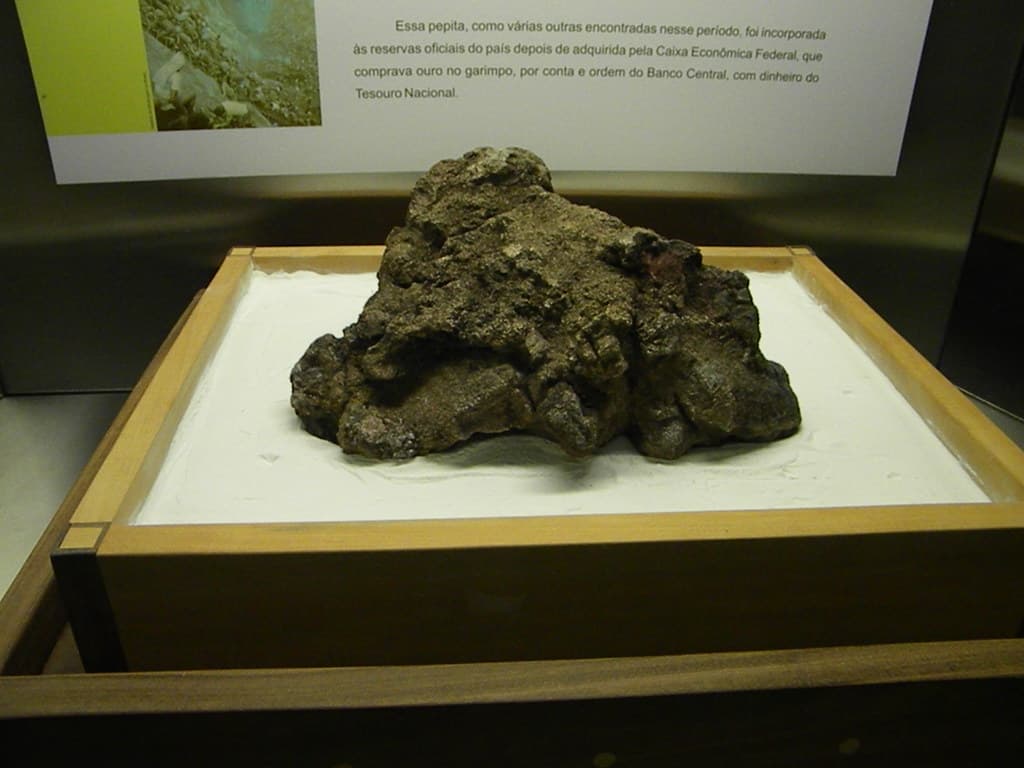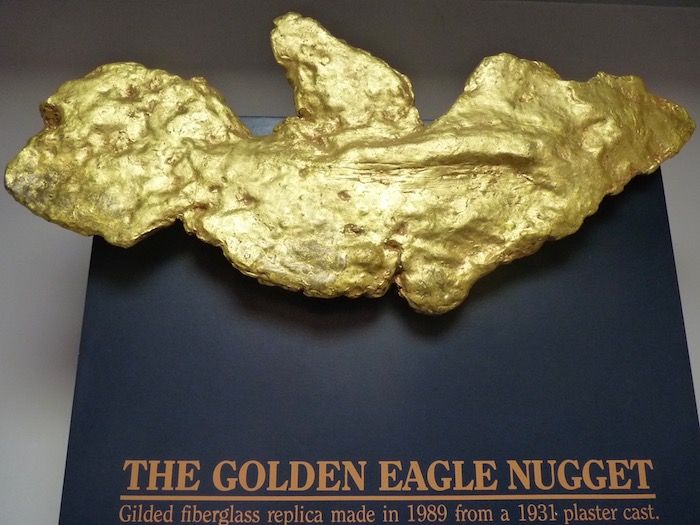A gold nugget is a naturally forming piece of gold acquired through placer mining operations. They can also be discovered in residual dumps where gold-bearing lodes or veins have endured.
Similarly, gold nuggets can be found in early mining processes of the tailing piles, mostly in those remains ignored by gold-mining diggers. They are typically fine at around 83% to 92% by mass (or 20K to 22K purity).
Meta Description: Here, we have the list of the Largest Gold Nuggets that have been discovered throughout the world.
How are gold nuggets formed?

Some nuggets of gold formed as clusters of gold crystals due to very hot water in fissures and cracks in hard-rocks, mostly with quartz.
Afterward, the process of weathering released the gold nuggets, which were found in a stream because of gravity.
Nuggets are gold pieces that weathered out of a natural lode. They frequently show indications of abrasive refining by stream operation and may still retain quartz or other lode matrix substance inclusions.
Replica of the Welcome Nugget, which was found by miners of the Red Hill Mining Company on 10 June 1858. Source: lovemoney.com
A 2007 research investigation on Australian nuggets headed out speculative hypotheses of supergene creation through in-situ precipitation, bacterial concentration, or cold welding of smaller fragments, due to the crystal form of all of the nuggets studied suggested they originated at high temperatures beneath the earth (i.e.,hypogene formation).
Other valuable metals, including platinum, can create nuggets in exactly the same manner.
A subsequent examination of native gold from Arizona, the United States, determined by lead isotopes, indicates that a significant amount of the volume in alluvial gold nuggets in this location developed within the placer surroundings.
The Largest Gold Nuggets Ever Found
The finding of one of the world’s largest gold nuggets usually causes shockwaves across the mining sector, but it also entices the general individuals. Many gold seekers fantasize about discovering a lump of dense valuable metal.
Around the world, gold nuggets of different shapes have been located. They are usually crushed down and transformed into new products.
Several of the enormous nuggets had been melted down into ingots, keeping only historical accounts of their dimension and large quantities. Below, we have named some largest gold nuggets which were ever found in the world.
● Welcome Stranger, Australia

On 5 February 1869, Cornish miner John Deason discovered The Welcome Stranger in Moliagul, Victoria, Australia. It is regarded as the largest alluvial gold nugget that has been found, with a purified weight of 97.14 kilos (3,123 ozt).
Deason uncovered a gold nugget just below 3 cm (1.2 in) off the surface while looking near the roots of a tree. The cornish maintained his discovery secret until it was dark, then pulled out the treasure with his accomplice, Richard Oates. Then, the two hosted a party to reveal their discovery to the guests.
During the period of finding, there were no instruments that could weigh a nugget this big. Thus, it was crushed into three separate pieces on an anvil by blacksmith Archibald Walls from Dunolly.
Later on, John, along with Richard and their few pals, moved the nuggets to the London Chartered Bank of Australia in Dunolly, and they were given £9,000 as advance payment.
Eventually, the two discoverers earned £9,381 (approximately A$666,000 in 2018) for their nugget “Welcome Stranger.”
On 1 March 1869, a wood carving of the Welcome Stranger was released in The Illustrated Australian News for Home Reader. Source: Wikipedia.
It measured higher than the 69.0 kilos (2,217 ozt) “Welcome Nugget” found in 1858, in Central Highlands, Victoria, Australia. F. K. Orme, the goldfields warden, declared that 70.57 kilograms (2,269 ozt) of smelted gold had been collected from it, deducting scraps passed away by the discoverers, which were believed to amount to an additional 1.46 kilos (47 ozt).
● Welcome Nugget, Australia

On 9 June 1858, the Welcome Nugget was found by a team of twenty-two Cornish miners at the Red Hill Mining Company site at Bakery Hill (around the now intersection of Mair and Humffray Street) in Ballarat, Victoria, Australia.
It is a large gold nugget weighing 2,217 troy ounces (16 pennies) that was located at the top of a tunnel 55 meters (180 feet) down. I
t was slightly structured like a horse’s head, approximately around 49 cm (19 in) long, 15 cm (5.9 in) wide, and 15 cm (5.9 in) high, with a rough centered surface.
This is a model of the Welcome Nugget, found in Victoria, Australia in 1858. Source: Powerhouse Collection.
Welcome Nugget was founded by Richard Jeffery and tested by William Birkmyre of the Victoria-based Port Phillip Gold Company. It was surpassed eleven years later in 1869 (as well as in Victoria) by the finding of the larger Welcome Stranger, it is regarded as the second-largest gold nugget that has been discovered.
● Pepita Canaa

Pepita Canna also called Canaan Nugget is the world’s largest surviving gold nugget. In 1983, it was discovered by finder Júlio de Deus Filho in the Serra Pelada (‘Naked Mountain’) gold mining area of the Brazilian state of Pará.
This Cannan gold nugget contains 52.33 kgs of gold or 1682 troy ounces with a weight of 60.82 kgs. In 1984, Banco Central do Brazil purchased it.
Now, Pepita Canna is on exhibit at the “Gold Room ” of the central bank’s money museum in Brasilia, Brazil’s federal capital (Museu de Valores do Banco Central in Brazil). In particular, the Pepita Canaa nugget’s source nugget was really larger, but it fractured into numerous pieces while being extracted from the earth’s surface.
● Hand of Faith

The “Hand of Faith” is the largest gold nugget ever discovered employing a metal detector with dimensions of 47 cm* 20cm* 9 centimeters. It is a 27.66 kgs gold nugget with 875 troy ounces of gold, found by a local, Kevin Hillier, around the area of Kingower, Victoria.
Gold Nugget, Hand Of Faith, was discovered in Kingower, Victoria, by Kevin Hiller. Source: DUNOLLY MUSEUM.
On 8 October 1980, it was officially declared that the “Hand of Faith” gold nugget had been found, during a press conference in Melbourne, also participated by the Premier of Victoria Rupert James Hamer.
It was bought for more than a million dollars by the Golden Nugget Casino, Las Vegas, Nevada, United States. It is presently kept in the casino lobby on East Fremont Street, Las Vegas. Similarly, its replicas are on display at Golden Nugget Atlantic City, and Golden Nugget Laughlin.
● The Golden Eagle Nugget, Australia

Golden Eagle Nugget is an amazing replication of a historic discovery that can be observed along the Coolgardie-Esperance Highway in the present mostly uninhabited place of Widgiemooltha, Western Australia.
On 15 January 1931, a 16-year-old native called Jimmy Larcombe struck gold with his pick while working on the family’s farm.
The marvelous nugget discovered was 66 cm long, 29 cm tall, and 6.4 cm thick—the largest ever identified in Western Australia.
The replica of the Golden Eagle Nugget was found in Western Australia in 1931. Source: FLICKER.
The unveiling of this rich discovery, subsequently known as the Golden Eagle Nugget, spurred a gold rush centered primarily around the town of Larkinville.
The region was experiencing a financial crisis at the time, and the finding spurred significant investment and relocation of others seeking a similarly valuable find.
The Golden Eagles earned its name for its appearance, similar to the iconic bird, having the diameter representing large, widespread wings. It was offered for sale for £5,438 to the Australian State Government and crushed down to acquire money for the state.
● The Fricot Nugget, USA

The Fricot Nugget is a large crystalline gold nugget discovered approximately 200 feet under the surface in 1865, together with approximately 200 ounces of lesser nuggets. Miner William Russell Davis found it during mining at the Grit Mine near Spanish Dry Diggins in El Dorado County.
Later, it was shipped to New York, the United States, and was sold to Mr. Fricot, who used to reside in Grass Valley, California. The nugget has been exhibited around the world, specifically at the 1878 Paris Exposition.
The Fricot Nugget weighs 201 troy ounces and is one of the largest known gold masses surviving intact from the period of the gold rush. It is admired for its huge stature, but its unique and relatively rare crystal form elevates this nugget to peaks.
The gold’s extraordinary shape makes it even more uncommon and important to enthusiasts. Today, it’s on display at the Mineral Museum in Mariposa, California, and the California State Mining.
● The Heron Nugget, Australia
A great deal of the famous Victorian gold mines had been searched for gold by the mid-1850s. A form of the system had been created that granted tiny parcels of land known as “claims” for investors to begin digging or pan for searching gold.
Investors were given licenses that enabled them to explore their specific claims.
Areas that returned little or no gold were known as “duffers” and were quickly canceled by disappointed license holders.
Such assertions were usually redistributed to the many naive newcomers who were still driven to the goldmines by their hunger for gold.
In 1855, a crew of unskilled laborers was assigned to a property in Golden Gully that was thought to be barren on the Mount Alexander goldfield. But the cruel plan quickly failed in this case. A team of miners discovered a 1008-ounce gold nugget on their second try of digging, which transformed the course of their lives eternally. The nugget is named after its discoverer Mr. Heron (who was a gold commissioner), so it is known as the Heron nugget.
Summary
Large-size nuggets can still be discovered around the globe. Reportedly, an amateur gold prospector found a large gold nugget near the city of Ballarat, in Victoria, on 16 January 2013.
The nugget with a Y-shape weighed nearly above 5 kgs i.e. 11 lb, with a height of 22 cm and 15 cm wide.
And its market cost is slightly less than AU$ 300,000; still, many believe that it could have been even higher because it’s rarely found. The finding has raised a question on speculation that Victoria’s goldfields were drained in the 19th century.










